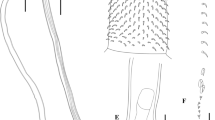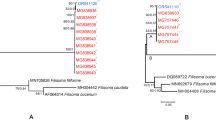Abstract
Members of the genus Lueheia Travassos, 1919, are endoparasites of birds, particularly passerines, throughout the Americas. Adults of Lueheia sp., (Plagiorhynchidae Golvan, 1960; Porrorchinae Golvan, 1956) were recovered from the intestine of the American robin (Turdus migratorius phillipsi Bangs) in Mexico City, and two other species of acanthocephalans identified as Porrorchis nickoli, (Plagiorhynchidae: Porrorchinae) Salgado-Maldonado and Cruz-Reyes, 2002 and Centrorhynchus microcephalus (Bravo-Hollis, 1947) Golvan, 1956 (Centrorhynchidae Van Cleave, 1916), were recovered from the Virginia opossum (Didelphis virginiana Allen) and groove-billed ani (Crotophaga sulcirostris Swainson), respectively in southeastern Mexico. Specimens of three species were sequenced at two molecular markers, the small subunit (SSU) and large subunit (LSU) of the nuclear rDNA and compared with other sequences available in GenBank. Maximum likelihood and Bayesian inference analyses of the combined (LSU + SSU) dataset and each individual dataset revealed that the specimens of Lueheia sp. formed an independent lineage, which is recognized herein as a new species, Lueheia aztecae n. sp., representing the fifth species of the genus in the Americas, and the second in the Nearctic region. The new species can be morphologically distinguished from the other five species in the genus by having a cylindrical proboscis, armed with 24–26 longitudinal rows with 9–10 hooks each. Phylogenetic inference performed with the combined dataset consisting of two genes (LSU + SSU) revealed that Lueheia aztecae n. sp. and P. nickoli belonging to subfamily Porrorchinae, formed two independent lineages, indicating that the subfamily is paraphyletic. Porrorchis nickoli and C. microcephalus formed a clade with other species of the genus Centrorhynchus, suggesting that P. nickoli should be transferred to genus Centrorhynchus, to form C. nickoli n. comb. In addition, we briefly discuss the ecological associations between the members of the families Plagiorhynchidae and Centrorhynchidae.





Similar content being viewed by others
References
Acosta-Virgen K, López-Caballero J, García-Prieto L, Mata-López R (2015) Helminths of three species of opossums (Mammalia, Didelphidae) from Mexico. Zookeys 511:131–152. https://doi.org/10.3897/zookeys.511.9571
American Ornithologists’ Union (AOU). (1998) Check-list of North American birds. 7th ed. 829 pp. Washington, DC, AOU
Amin OM (2013) Classification of the Acanthocephala. Folia Parasitol 60:273–305
Amin OM, Heckmann RA, Wilson E, Keele B, Khan A (2015) The description of Centrorhynchus globirostris n. sp. (Acanthocephala: Centrorhynchidae) from the pheasant crow, Centropus sinensis (Stephens) in Pakistan, with gene sequence analysis and emendation of the family diagnosis. Parasitol Res 114:2291–2299
Bravo-Hollis M (1947) Gordiorhynchus microcephalus n. sp., acantocephalo parasito de un pajaro (Cassidix mexicanus mexicanus Gmelin). Anales Inst Biol Univ Nac Auto Mex 18:499–506
García-Prieto L, García-Varela M, Mendoza-Garfias B, Pérez-Ponce de León G (2010) Checklist of the Acanthocephala in wildlife vertebrates of Mexico. Zootaxa 2419:1–50
García-Varela M, Nadler SA (2005) Phylogenetic telationships of Palaeacanthocephala (Acanthocephala) inferred from SSU and LSU rRNA gene gequences. J Parasitol 91:1401–1409
García-Varela M, Pérez-Ponce de León G (2008) Validating the systematic position of Profilicollis Meyer, 1931 and Hexaglandula Petrochenko, 1950 (Acanthocephala: Polymorphidae) using cytochrome c oxydase (Cox 1). J Parasitol 94:212–217
García-Varela M, Pérez-Ponce de León G, Aznar FJ, Nadler SA (2009) Systematic position of Pseudocorynosoma and Andracantha (Acanthocephala, Polymorphidae) based on nuclear and mitochondrial gene sequences. J Parasitol 95:178–118. https://doi.org/10.1645/GE-1538.1
García-Varela M, Pérez-Ponce de León G, Aznar FJ, Nadler SA (2011) Erection of Ibirhynchus gen. nov. (Acanthocephala: Polymorphidae), based on molecular and morphological data. J. Parasitol 97: 97–105. https://doi.org/10.1645/GE-2350.1
García-Varela M, Pérez-Ponce de León G, Aznar FJ, Nadler SA (2013) Phylogenetic relationships among genera of Polymorphidae (Acanthocephala), inferred from nuclear and mitochondrial gene sequences. Mol Phylogenet Evol 68:176–184. https://doi.org/10.1016/j.ympev.2013.03.029
García-Varela M, Park JK, Hernández-Orts JS, Pinacho-Pinacho CD (2019) Morphological and molecular data on a new species of Plagiorhynchus Lühe, 1911 (Acanthocephala: Plagiorhynchidae) from the long-billed curlew (Numenius americanus) from northern Mexico. J Helminthol 22. https://doi.org/10.1017/S0022149X19000543
Golvan YJ (1956) Acanthocéphales d’oiseaux Troisième note. Revision des especes européenes de la sous-familledes Plagiorhynchinae A. Meyer, 1931 (Polymorphidae). Ann Parasitol Hum Comp 3:350–384
Guillén-Hernández S, García-Varela M, Pérez-Ponce de León G (2008) First record of Hexaglandula corynosoma (Travassos, 1915) Petrochenko, 1958 (Acanthocephala: Polymorphidae) in intermediate and definitive host in Mexico. Zootaxa 1873:61–68
Howell SNG, Webb S (1995) A guide to the birds of Mexico and Northern Central America. 851pp. New York, Oxford University Press
Kemper LD, Taylor MJ (1981) Seasonal reproductive changes in the American robin (Turdus migratorius L.) of the Pacific Northwest. Can J Zool 59:212–217. https://doi.org/10.1139/z81-035
Lagrue C, Heaphy K, Presswell B, Poulin R (2016) Strong association between parasitism and phenotypic variation in a supralittoral amphipod. Mar Ecol Prog Ser 553:111–123
Lisitsyna O, Tkach VI, Bush S (2012) New records of Acanthocephalans from birds in the Philippines with a description of a new Porrorchis species identification keys for the genus. J Parasitol 98:1176–1184. https://doi.org/10.1645/GE-3116.1
López-Caballero J, Mata-López R, García-Varela M, Pérez Ponce de Léon G (2015) Genetic divergence of Oligacanthorhynchus microcephalus (Acanthocephala:Archiacanthocephala: Oligacanthorhynchidae), parasite of three species of opossum (Mammalia:Didelphidae) across Central and Southeastern Mexico. Com Parasitol 82:175–186. https://doi.org/10.1654/4742.1
Monks S (2001) Phylogeny of the Acanthocephala based on morphological characters. Syst Parasitol 48:81–116
Near TJ, Garey JR, Nadler SA (1998) Phylogenetic relationships of the Acanthocephala inferred from 18S ribosomal DNA sequences. Mol Phylogenet Evol 10:287–298
Pinacho-Pinacho CD, García-Varela M, Sereno-Uribe AL, Pérez-Ponce de León G (2018) A hyper-diverse genus of acanthocephalans revealed by tree-base and non-tree based species delimitation methods: ten cryptic species of Neoechinorhynchus in Middle America freshwater fishes. Mol Phylogenet Evol 127:30–45
Posada D (2008) jModelTest: phylogenetic model averaging. Mol Biol Evol 25:1253–1256
Rambaut A (2012) FigTree v1.4.0. Institute of Evolutionary Biology. Edinburgh, University of Edinburgh
Richardson JD, Nickol BB (1995) The genus Centrorhynchus (Acanthocephala) in North America with description of Centrorhynchus robustus n. sp., redescription of Centrorhynchus conspectus, and a key to species. J Parasitol 81:767–772
Richardson JD, Monks S, García-Varela M, Pulido-Flores G (2010) Redescription of Centrorhynchus microcephalus (Bravo–Hollis, 1947) Golvan, 1956 (Acanthocephala: Centrorhynchidae) from the Groove-Billed Ani (Crotophaga sulcirostris) in Veracruz, Mexico. Comp Parasitol 77:164–171. https://doi.org/10.1654/4412.1
Ronquist F, Teslenko M, Van Der Mark P, Ayres DL, Darling A, Hohna S, Larget B, Liu L, Suchard MA, Huelsenbeck JP (2012) MrBayes 3.2: Efficient Bayesian phylogenetic inference and model choice across a large model space. Syst Biol 61: 539–542.
Salgado-Maldonado G, Cruz-Reyes A (2002) Porrorchis nickoli n. sp. (Acanthocephala: Plagiorhynchidae) from mammals in Southeastern Mexico, first known occurrence of Porrorchis in the Western Hemisphere. J. Parasitol 88:146–152
Smales LR (2002) Plagiorhynchidae Meyer, 1931 (Acanthocephala) from Australasian birds and mammals, with descriptions of Plagiorhynchus (plagiorhynchus) menurae (Johnston, 1912) and P. (P). allisonae n. sp. Syst Parasitol 51:2017–2216
Smales LR (2013) Acanthocephala including the descriptions of new species of Centrorhynchus (Centrorhynchidae) and the redescription of Lueheia scripta (Westrumb, 1821) (Plagiorhynchidae) from birds from Paraguay, South America. Rev. Suisse Zool 120:175–202
Stamatakis A (2006) RAxML-VI-HPC: Maximum likelihood-based phylogenetic analyses with thousands of taxa and mixed models. Bioinformatics 22:2688–2690
Steinauer M, Flores V, Rauque C (2020) Centrorhynchus nahuelhuapensis n. sp. (Acanthocephala: Centrorhynchidae) from rufous-legged owl (Strix rufipes King) in Patagonia. J Helminthol 94:1–7. https://doi.org/10.1017/S0022149X18001220
Thompson JD, Gibson TJ, Plewniak F, Jeanmougin F (1997) The Clustal windows interface: flexible strategies for multiple sequence alignment aided by quality analysis tools. Nucleic Acids Res 25:4876–4882
Werby HI (1938) A new genus of Acanthocephala with forked lemnisci. Trans Am Microsc Soc 57:204–212
Acknowledgments
We thank to Luis García-Prieto for providing specimens deposited at the CNHE. Laura Márquez and Nelly López Ortiz for their help with the automatic sequencer. The American robin specimen was collected by Martin Figueroa B. and Paola Chavez; other specimens were collected under the Cartilla Nacional de Colector Científico (FAUT 0202) issued by the Secretaría del Medio Ambiente y Recursos Naturales (SEMARNAT) to MGV. This research was partially supported by grants from the Programa de Apoyo a Proyectos de Investigación e Innovación Tecnológica (PAPIIT-UNAM) IN207219 and IN220113 to MGV and RML respectively. LAG thanks the support of the Programa de Posgrado en Ciencias Biológicas, UNAM, and CONACYT for granting a scholarship to complete his PhD program.
Author information
Authors and Affiliations
Corresponding author
Additional information
Section Editor: Simonetta Mattiucci
Publisher’s note
Springer Nature remains neutral with regard to jurisdictional claims in published maps and institutional affiliations.
Rights and permissions
About this article
Cite this article
García-Varela, M., Andrade-Gómez, L., López-Caballero, J. et al. Morphological and molecular data reveal a new species of Lueheia (Acanthocephala: Plagiorhynchidae) from Turdus migratorius (Turdidae) in central Mexico and its phylogenetic implications within the family. Parasitol Res 119, 3221–3231 (2020). https://doi.org/10.1007/s00436-020-06748-7
Received:
Accepted:
Published:
Issue Date:
DOI: https://doi.org/10.1007/s00436-020-06748-7




